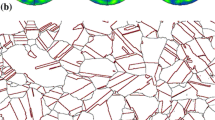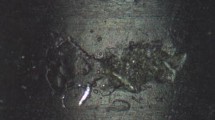Abstract
Nickel-base wear materials are typically used as weld hardfacing deposits, or as cast or hot isostatically pressed (HIP) inserts that provide the needed wear resistance to a base material with the desired mechanical properties. Most nickel-base wear materials contain high levels of chromium, silicon, carbon, and boron, which results in complex microstructures that are comprised of high volume fractions of silicide, carbide, and/or boride phases. The volume fraction of nickel-phase dendrite regions typically ranges from 40 to 70 pct, and these dendrite-phase particles are individually isolated by a matrix of silicide, carbide, and boride phases. The continuous matrix of brittle silicide, carbide, and boride phases results in a low damage tolerance for nickel-base wear materials, which is a concern in applications that involve high stresses, thermal transients, or shock loading.
Fatigue crack growth (FCG) and fracture toughness (K IC) testing in accordance with ASTM E399 methods has been used to quantify the damage tolerance of various nickel-base wear materials. Fractographic and microstructure examinations were used to define a generic toughening mechanism for nickel-base wear materials. The toughness of nickel-base wear materials is primarily controlled by the plastic deformation of the nickel-phase dendrites in the wake of a crack moving through the matrix of brittle silicide, carbide, and/or boride phases, i.e., crack bridging. Measured K IC values are compared with calculated K IC values based on the crack-bridging model. Microstructure examinations are used to define and confirm the important aspects of the crack-bridging model. This model can be used to predict the toughness values of nickel-base wear materials and direct processing methods to improve the K IC values.
Similar content being viewed by others
References
S.A. Shiels, W.L. Wilson, K.W. Rosengarth, and G.L. Wire: Proc. 3rd Int. Symp. on Contribution of Materials Investigation to the Reduction of Problems Encountered in Pressurized Water Reactors, Fontevraund, France, 1994; available as WAPD-T-3032, DOE/OSTI, Oak Ridge, TN, 1994, pp. 1–8.
B.V. Cockeram, R.F. Buck, and W.L. Wilson: Surf. Coatings Technol., 1997, vols. 94–95, pp. 495–500.
B.V. Cockeram: Surf. Coatings Technol., 1998, vols. 108–109, pp. 377–84.
J.R. Davis: Materials Handbook, vol. 6, Welding, Brazing, and Sodering, ASM INTERNATIONAL, Materials Park, OH, 1993, pp. 789–829.
P. Crook and H.N. Farmer: Materials Handbook, vol. 18, Friction, Lubrication, and Wear Technology, ASM INTERNATIONAL, Materials Park, OH, 1992, pp. 758–65.
A.G. Evans: J. Am. Ceram. Soc., 1990, vol. 73, pp. 187–206.
M.F. Ashby, F.J. Blunt, and M. Bannister: Acta Metall., 1989, vol. 37, pp. 1847–57.
Standard Test Method for Plane-Strain Fracture Toughness of Metallic Materials, ASTM E399-90, ASTM, Philadelphia, PA, 1990.
Standard Practice for Reporting Uniaxial Strength Data and Estimating Weibull Distribution Parameters for Advanced Ceramics, ASTM C1239-95, ASTM, Philadelphia, PA, 1995.
S. Suresh: Metall. Trans. A, 1985, vol. 16A, pp. 249–60.
N.S. Stoloff: Materials Handbook, vol. 1, Properties and Selection: Irons, Steels, and High Performance Alloys, ASM INTERNATIONAL, Materials Park, OH, 1990, pp. 950–1007.
K. Tanaka and K. Hidaka: U.S. Patent 4,404,049, Sept. 13, 1990.
R.O. Ritchie: Int. Met. Rev., 1979, vol. 20, pp. 205–30.
C.J. Gilbert, J.J. Cao, W.J. Moberlychan, L.C. Dejonghe, and R.O. Ritchie: Acta Metall. Mater., 1996, vol. 44, pp. 3199–3214.
K.T. Venkateswara Rao, C.J. Gilbert, and R.O. Ritchie: in Processing and Design Issues in High Temperature Materials, N.S. Stoloff and R.H. Jones, eds., TMS, Warrendale, PA, 1997, pp. 209–20.
K.S. Ravichandran: Scripta Metall. Mater., 1992, vol. 26, pp. 1389–93.
D.E. Alman and N.S. Stoloff: Metall. Trans., 1995, vol. 26A, pp. 289–304.
J. Kajuch, J. Short, and J.J. Lewandowski: Acta Metall. Mater., 1995, vol. 43, pp. 1955–67.
H.E. Deve, A.G. Evans, G.R. Oddette, R. Mehrabian, M.L. Emiliani, and R.J. Hecht: Acta Metall. Mater. Mater., 1990, vol. 38, pp. 1491–1502.
C. Wagner: Z. Elektrochem., 1961, vol. 65, pp. 581–89.
A. Kelly and G.W. Groves: Crystallography and Crystal Defects, Addison-Wesley Publishing Co., New York, NY, 1970, p. 344.
G.B. Fedarov and E.A. Smirnov: in Diffusion Processes in Metals, V.N. Svechnikov, ed., Akademiya Nauk Ukrainskoi SSR, National Bureau of Standards, Washington, D.C., 1970.
Author information
Authors and Affiliations
Rights and permissions
About this article
Cite this article
Cockeram, B.V. The fracture toughness and toughening mechanisms of nickel-base wear materials. Metall Mater Trans A 33, 33–56 (2002). https://doi.org/10.1007/s11661-002-0004-x
Received:
Issue Date:
DOI: https://doi.org/10.1007/s11661-002-0004-x




